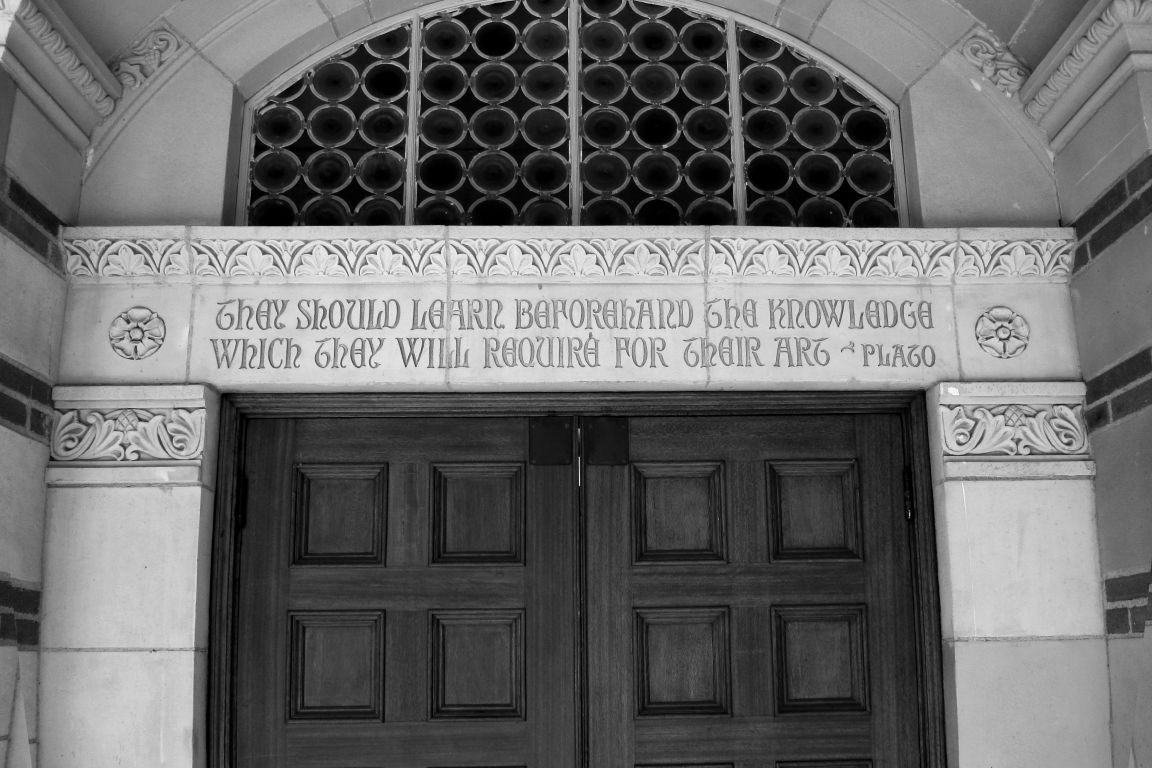You may think you know the UCLA campus well. But have you taken the time to really notice the murals, ceiling paintings and inscriptions?
Royce Hall, for example, features ornamentation reminiscent of the Italian Romanesque style of architecture that inspired original university architects David Allison and George W. Kelham. Notice the murals on the ceilings of the two porches. On the lower porch, look up to see paintings representing what Ernest Carroll Moore, the university’s first chief executive officer, called the “12 professions.” Can you spot your field of study? If it’s history, mathematics, biology or music, it’s there.
The inscriptions Moore chose for Royce’s main entrances also reflect themes of education and learning. From Plato: “They should learn beforehand the knowledge which they will require for their art.” Moore explained that in this case, art referred to “the great art of living and of education.” From the building’s namesake, philosopher and educator Josiah Royce: “The world is a progressively realized community of interpretation.” For Moore, that was the essence of Royce’s doctrine, “the sum and conclusion of all his teaching.”
Head to the second-floor portico, where the painted ceiling depicts Moore’s concept of the “Instruction of the World,” divided into ancient, medieval and modern times. Among the 12 honored figures — four from each period — are Socrates, Petrarch and Albert Einstein.
And above the stage in Royce Auditorium: “Education is learning to use the tools which the race has found indispensable,” a quote from Moore himself, transferred from the first UCLA campus, on Vermont Avenue. According to Moore, it was brought along to “show the historic unity between the institutions.”
Across the quad, Powell Library is also rich in Romanesque details, such as the dwarfish figures and leaf-scroll designs on the columns, and the beings — human and animal — on the walls near the entryway. Notice the symbols of science and discovery on the archway of the entrance, and the owl of Minerva (Roman goddess of wisdom), flanked by the gods of light and learning, above the door. In the foyer, check out the blue-and-gold tiled pillars topped with — what else? — small bruins.
At the Humanities Building, originally the Physics-Biology Building, notice the California motif by the east entrance, reflected in the bas-reliefs of Golden State symbols such as a mission, ranch house and bear. Depictions of a 19th-century covered wagon and locomotive and a 1920s-style automobile and airplane reflect old and “new” California. Above the first-floor windows, bears, suns, fish and other brick-tiled images wrap around the structure.
Like Royce Hall, the building greets visitors with thought-provoking inscriptions at its entrances. Above the south door, from scientist Michael Faraday: “Nothing is too wonderful to be true.” A Biblical citation tops the east entryway: “Open thou mine eyes, that I may behold wondrous things out of thy law.”
On to the Student Activities Center, originally the Men’s Gymnasium. Bas-reliefs of burly sportsmen — baseball and football players, rowers, swimmers — border the three north doors. Maybe a foreshadowing of the strength of Bruin athletics?
Finally, to the Anderson School complex, where a much newer inscription was added on one of the courtyard columns in 1995: “May La Force Be With You” pays tribute to Clayburn La Force, an economist who was dean of UCLA Anderson and spearheaded construction of the complex.
The next time you’re on campus, don’t hurry past familiar haunts. Stop and take a closer look.





